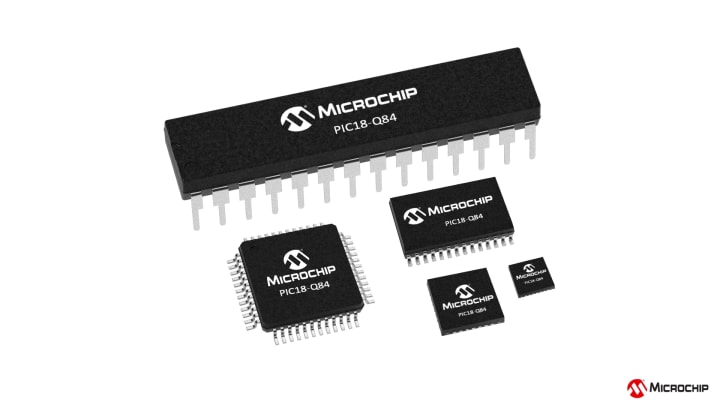MCUs that Combine CAN Flexible Data-Rate (FD) and Core Independent Peripherals to Increase System Capabilities
The PIC18-Q84 family of MCUs combines an extensive array of Core Independent Peripherals (CIPs) with Controller Area Network Flexible Data Rate (CAN FD) for automotive interface and smart sensor networks. Available with up to 128 KB of Flash memory and in packages with up to 48 pins, these cost-optimized MCUs also introduce new peripherals like the Universal Timer (UTMR) with customization capability and the addition of context switching to the 12-bit Analog-to-Digital Converter with Computation for automating analog signal analysis for real-time system response. They also include industry-standard options like JTAG boundary scan and 32-bit Cyclic Redundancy Check (CRC) with memory scan on boot for added system safety. Because these hardware-based CIPs are so easy to configure, there’s no longer any need to write and validate an entire software routine to accomplish a task. This speeds up and simplifies your development so you can focus other aspects of your design.

Getting Started
Take your next idea to market with a cost-effective development board that you can keep in your pocket. With its full programming and debugging capabilities, the PIC18F57Q84 Curiosity Nano Evaluation Kit (DM182030) offers complete support for your next design.
The PIC18-Q84 family is designed to integrate with MPLAB® Code Configurator (MCC), a free software plug-in for our award-winning MPLAB X Integrated Development Environment (IDE), that provides a graphical interface to easily configure peripherals and functions specific to your application. Code examples are also available to help you immediately start your development.

System Features
Improved Peripheral Performance
Controller Area Network Flexible Data-Rate (CAN FD)
The CAN FD module transmits and receives data faster to meet the demand for increased bandwidth in CAN applications. The CAN FD module works with CAN 2.0B and is fully backwards compatible with previous CAN modules. The 12-bit ADC with Computation now has context switching to improve automating analog signal analysis for real-time system response.
Design Flexibility
16-bit Universal Timer
The two customizable 16-bit Universal Timers (UTs) can be combined to make a larger timer to deliver advanced capabilities beyond those found on standard timer modules. The PIC18-Q84 family of MCUs also has improved and flexible serial communications interfaces including a UART with support for Asynchronous, DMX, DALI and LIN protocols, plus higher-speed, standalone I2C and SPI modules.
Safety First
Functional Safety Ready, JTAG Boundary Scan
To help you implement functional safety in your application based on the IEC 60730 Class B Safety and UL 1988 requirements, the Windowed Watchdog Timer (WWDT) and the 32-bit CRC with Scan with on-boot capability work in tandem to ensure the integrity of the program Flash contents. These MCUs also offer JTAG boundary scan for testing complex circuitry in PCBs. A Failure Modes, Effects, and Diagnostic Analysis (FMEDA) report and Safety Manual are also available for these MCUs.
Integrated Analog
12-bit ADCC with Context Switching, 8-bit DAC, ZCD
The on-chip integrated analog peripherals include Zero Cross Detect (ZCD), comparators, a 8-bit Digital-to-Analog Converter (DAC) and a 12-bit Analog-to-Digital Converter with Computation (ADCC) and context switching that automates Capacitive Voltage Divider (CVD) techniques for implementing advanced touch sensing, averaging, filtering, oversampling and automatic threshold comparison.
Layout Flexibility
Peripheral Pin Select (PPS)
Peripheral Pin Select (PPS) provides ultimate flexibility when routing digital signals to device pins. With PPS, any digital peripheral can be connected to any I/O pin on the fly for a customized layout. This allows you to maintain layout compatibility with older PIC® MCUs, even as new features are implemented.
Improved System Performance
Direct Memory Access (DMA)
The PIC18-Q84 family is equipped with eight Direct Memory Access (DMA) controllers for data transfers between all memory spaces and peripherals independent of the CPU. This enhances system performance and improves power consumption. Vectored Interrupts (VIs) reduce response time by introducing an interrupt hierarchy and directly executing Interrupt Service Routines (ISRs).
Hardware Customization
Custom Logic
The on-chip Custom Logic peripherals on PIC and AVR MCUs eliminate the need for external components and complicated design work. With these on-chip peripherals, you can apply customized logic without physically expanding your application’s size.
Power-Conserving Functionality
IDLE, DOZE, Peripheral Module Disable (PMD)
IDLE and DOZE low-power modes allow you to optimize your application for device performance and power consumption. The Peripheral Module Disable (PMD) allows unused peripherals to be turned off individually, further reducing power consumption.